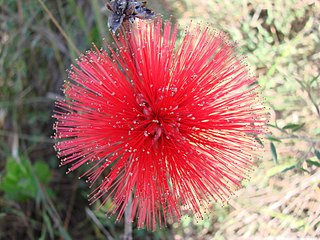
Calliandra is a genus of flowering plants in the pea family, Fabaceae, in the mimosoid clade of the subfamily Caesalpinioideae. It contains about 140 species that are native to tropical and subtropical regions of the Americas.

Calliandra brevipes, the pink powderpuff, is an attractive shrub with finely divided leaves and clusters of red powder-puff flowers. It is native to southeastern Brazil, Uruguay, and northern Argentina.

Vitis riparia Michx, with common names riverbank grape or frost grape, is a vine indigenous to North America. As a climbing or trailing vine, it is widely distributed across central and eastern Canada and the central and northeastern parts of the United States, from Quebec to Texas, and eastern Montana to Nova Scotia. There are reports of isolated populations in the northwestern USA, but these are probably naturalized. It is long-lived and capable of reaching into the upper canopy of the tallest trees. It produces dark fruit that are appealing to both birds and people, and has been used extensively in commercial viticulture as grafted rootstock and in hybrid grape breeding programs.

Calliandra eriophylla, commonly known as fairy duster, is a low spreading shrub which is native to deserts and arid grasslands in California, Arizona, New Mexico and Texas and Mexico.

Calliandra californica, the Baja fairy duster, is an evergreen, woody shrub which is native to Baja California, Mexico. In Spanish, the plant is also known vernacularly as tabardillo,zapotillo or chuparosa. The flowers, which appear in early summer, have clusters of red stamens. The shrub is usually between 0.6 and 1.8 metres in height and has bipinnate leaves. The leaves have been described as "fern-like." Leaves close at night time.
Calliandra bella is a species of flowering plants of the genus Calliandra in family Fabaceae.
Calliandra conferta is a species of flowering plants of the genus Calliandra in the family Fabaceae.
Calliandra cruegeri is a species of flowering plants of the genus Calliandra in the family Fabaceae.

Calliandra dysantha is a species of flowering plants of the genus Calliandra in the family Fabaceae. Is native to Brazil.
Calliandra foliolosa is a species of flowering plants of the genus Calliandra in the family Fabaceae.

Calliandra haematocephala is a species of flowering plants of the genus Calliandra in the family Fabaceae.

Calliandra houstoniana is a species of flowering plants of the genus Calliandra in the family Fabaceae.
Calliandra laxa is a species of flowering plants of the genus Calliandra in the family Fabaceae.

Calliandra parvifolia is a species of flowering plants of the genus Calliandra in the family Fabaceae.
Calliandra peninsularis is a species of flowering plants of the genus Calliandra in the family Fabaceae. It is endemic to Baja California Sur state in Mexico.

Carex riparia, the greater pond sedge, is a species of sedge found across Europe and Asia. It grows in a variety of wet habitats, and can be a dominant species in some swamps. It is Britain's largest Carex, growing up to 130 cm tall, with glaucous leaves up to 160 cm long. It hybridises with a number of other Carex species, including the closely related Carex acutiformis – the lesser pond sedge. A variegated cultivar is grown as an ornamental grass.
Hollandaea riparia, sometimes named roaring Meg hollandaea, is a species of Australian rainforest tree, in the plant family Proteaceae.

Calliandra calothyrsus is a small leguminous tree or large shrub in the family Fabaceae. It is native to the tropics of Central America where its typical habitat is wet tropical forests or seasonally dry forests with a dry season of four to seven months, when it may become deciduous. This tree grows to about 6 m (20 ft) and has pinnate compound leaves and flowers with a boss of prominent reddish-purple stamens. It is not very drought-tolerant and the above-ground parts are short-lived but the roots regularly resprout.
Isoetes riparia, the shore quillwort, is a species of plant in the family Isoetaceae. It can be found in rivers, creeks, and tidal mud flats in southern Quebec and southeastern Ontario, south to eastern New York. It has 5 to 35 long, erect bright green to yellow-green leaves, which are 6 to 35 centimeters long. The velum covers one fourth of the sporangium, which can be 7 millimeters long and 4 millimeters wide. The elongated ligule can grow to be 3 millimeters long. The spherical megaspores are 430 to 680 micrometers in diameter with closely set ridges. The kidney-shaped microspores are 24-35 micrometers long, and usually have spine-tipped tubercules. The megaspores can sometimes come to resemble that of either I. echinospora, if the megaspores become eroded and bear projections that could resemble spines, or I. macrospora, if the broken ridges take a certain shape.











